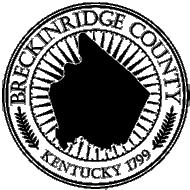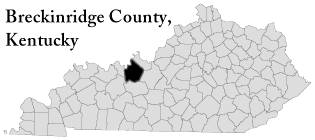 |
USGenWeb Archives Project Breckinridge County, Kentucky |
 |
 |
 |
 |
 |
USGenWeb Archives Project Breckinridge County, Kentucky |
 |
 |
 |
 |
THESE
ARCHIVES BUILT BY YOUR
CONTRIBUTIONS.
PLEASE CONTRIBUTE TODAY!
New
Easy to use Submission
Forms!
This Page Updated Monday, 11-Apr-2022 20:27:42 EDT
| BRECKINRIDGE COUNTY, KENTUCKY |
| AREA COMMUNTIES OF THE PAST AND PRESENT |
| BIG BILL HARDIN AND THE FORT |
William Hardin was a real pioneer, known as “Big
Bill.”
He was of large physique, and a capable leader.
He was not only a great warrior, fighting
back the Indians, but was also a man engaged in the business and
political life of the community.
There were three brothers, French Huguenots, who, in order
to
escape religious persecution in France fled to Canada.
The extreme cold of the Canadian climate
caused them to emigrate to Virginia.
Two of the brothers settled there permanently, the other
emigrated to South Carolina. From
the brothers who settled
in Virginia, descended the Kentucky Hardins.
John, Martin, and William came to Kentucky and William was
the
pioneer of Breckinridge
County.
John Hardin, for whom Hardin County was named, was
murdered by
the Indians in 1792, while on an embassy to
their county.
Lydia Hardin, a sister, married Charles Wickliff, and was
the
mother of distinguished men and eminent statesmen.
Sarah, another sister, married her cousin, Ben Hardin, and
was
the mother of the great criminal lawyer, Ben Hardin.
William Hardin (Big Bill) was born in 1747. He married
Winifred Holtsclaw and they had eight children.
His wife having died, he was married a second time to
Susannah
McGee, July 9, 1808. The
children of the first marriage
were:
Winnie Ann, who married William
Comstock. This lady
grew, picked, carded, spun, and wove
the cotton into cloth from
which she made her wedding gown. Henry
Hardin, lived and died on a farm in Sugar Tree Run in
Breckinridge County. Malinda
married William Crawford, died and was
buried in
the Fort. William
was postmaster in Frankfort for many
years.
Elijah was killed at Hustons Springs in Hardinsburg in
1815. The
other children were Amelia, John, and Jehu.
Colonel Hardin also reared a niece and
nephew. Daniel
Hardin and Polly, his sister who later
married Ben Huff, the first sheriff
of Grayson County.
John Hardin, William’s uncle, also made his home
with this
daring nephew, and was murdered by Indians, it was generally
supposed a short distance from the Fort on
what
is now the Old Brandenburg Road.
Colonel William Hardin and his party had floated down the
Ohio
River as far as the Falls at Louisville.
Here they remained
for a short time but not liking the lay of
the
land he and a party of five men floated on down the river looking
for a place to make a colony as
he called it.
Upon reaching the point where
Stephensport now stands, he liked the looks of the country, and
sailed from the Ohio River up
Sinking Creek to the Falls near where
Sample is.
It so happened that there was a part of Indians at the
falls
where they landed. They
left their boat and went overland,
followed by the Indians, to the present
sight of
Hardinsburg where Big Bill declared the place for his colony.
By the time they reached the spot which they would choose
for
their colony they realized they were being followed by Indians
in superior numbers.
They decided to avoid
a fight by traveling over land to Hines Fort, now Elizabethtown,
which was established the year
before, 1779.
By traveling all night they
reached a large spring near Rough Creek, where they stopped to
slake their thirst and rest for a
few minutes.
“It is probable that this
is where Big Springs is now.”
It was at this point
that the Indians caught up with Hardin’s party,
and a fight followed.
One of the group Mr.
St. Clair was killed but Big Bill and the rest escaped to Hines
Fort.
Determined to establish his colony he returned the
following
spring with twelve families and built a typical frontier fort of
stockade
walls and watch towers at the corners, and
several cabins near the fort. This
was the last pioneer
fort built on the frontier, and the fartherest
west of any frontier fort in America. When
his settlement was completed, news came of an Indian Village
being built on the Saline Creek in
Illinois.
Hardin was not well pleased that the Indians should be in
such a
close vicinity to his little settlement so he secured a group of
eighty
men and went into Illinois to dislodge them.
When they arrived there were but three warriors guarding
the
village. They were
shot.
Hardin, then deployed his men to a small
forest surrounded by open land and on all sides to await the
return of the Indian party. When
they returned the battle was furious, often
hand-to-hand combat. Many
of the whites were killed. At
the outbreak of the battle,
Big Bill was shot through the leg. Sensing
the moral support his men needed, he climbed upon a huge fallen
chestnut log and continued to direct
the battle.
The Indians were all killed or
put to flight. This
battle was never reported to the
government and so has more often than
not been passed over by historians, but it
was
reputed to have been one of the bloodiest battles in the winning
of Kentucky. Among
the number
of the eighty men who went with Colonel
Hardin to
dislodge the Indians in Illinois, were:
Christopher
Bush, Samuel
Spencer, William McDaniels, William Luce, John Jolly, William
Weatherholt,
Charles Hamilton, John Bruner, ____
Brearshera,
James Jennings, William Kelso, Henry Dean, ___ Barger,
___ Carlyle, ___ Shiveley, Mordicia
Lincoln, John
Faith, ___ Miller, Samuel Crawford, Edgar Pate, Adam Barr,
Ben Huff, Ben Connstock, Horace Marry,
Archibal
Lockard, Daniel Meredith, ___ Haynes, ___ Hardiway,
___ Claycomb, ___ Payne, William Perrin,
___
Rice, Joseph Toby, ___ Taul, George Robards, Richard Stevens,
and ___ Lampton.
The descendants of many of the above families have
remained in
Breckinridge County, the place of their birth, and are
prominently
connected with the business, social, and
religious life of the county.
Colonel William Hardin wore a coveted trophy under his
coonskin
cap, and many a young Indian brave paid the supreme price for
trying
to collect it.
Among the Indians, he was
reported to have been killed more than once and as a result he
was feared by many as a ghost and has
dispersed large groups of them by just
being
seen.
The year after the fort was built, several acres of ground
had
been cleared and the settlers were planting corn.
Miss
Sarah McDonald,
a young girl, was dropping corn for Colonel
Hardin when they were attacked by the Indians.
Colonel
Hardin was shot through the lungs, a lesser
physique could not have survived. One
Indian warrior, realizing he was shot, came forward with his
knife to take Big Bill’s scalp.
Sarah
handed Colonel Hardin his rifle which he
pointed
at the Indian causing him to run back.
Sarah finally
succeeded in getting Colonel Hardin his gun
and said, “Point it at him, Mr.
Bill or
he’ll kill us both.”
With great effort Big Bill
pointed his gun at the Indian who retreated until Sarah, too,
could
get on the horse and they reached the
safety of
the stockade.
Colonel Hardin did not shirk his political
responsibilities.
From 1810-1813, he was a member of the legislature of
Kentucky.
All residents of Breckinridge County are recipients of
Colonel
Hardin’s charity and foresight.
Whether we sit on the
courthouse rail and whittle, or once a year
visit
the sheriff’s office to pay taxes; whether we hold political
office in the courthouse or pay for our misbehavior
in jail, we are on ground donated to
Breckinridge
County as a public property by this great man.
This magnificent man died in Breckinridge County, and lies
today
in an unmarked grave near U. S. 60 Highway and Hardin’s
Creek.
No one knows his exact burial place
to any closer tolerance than one acre.
What an end to our
county’s greatest pioneer!